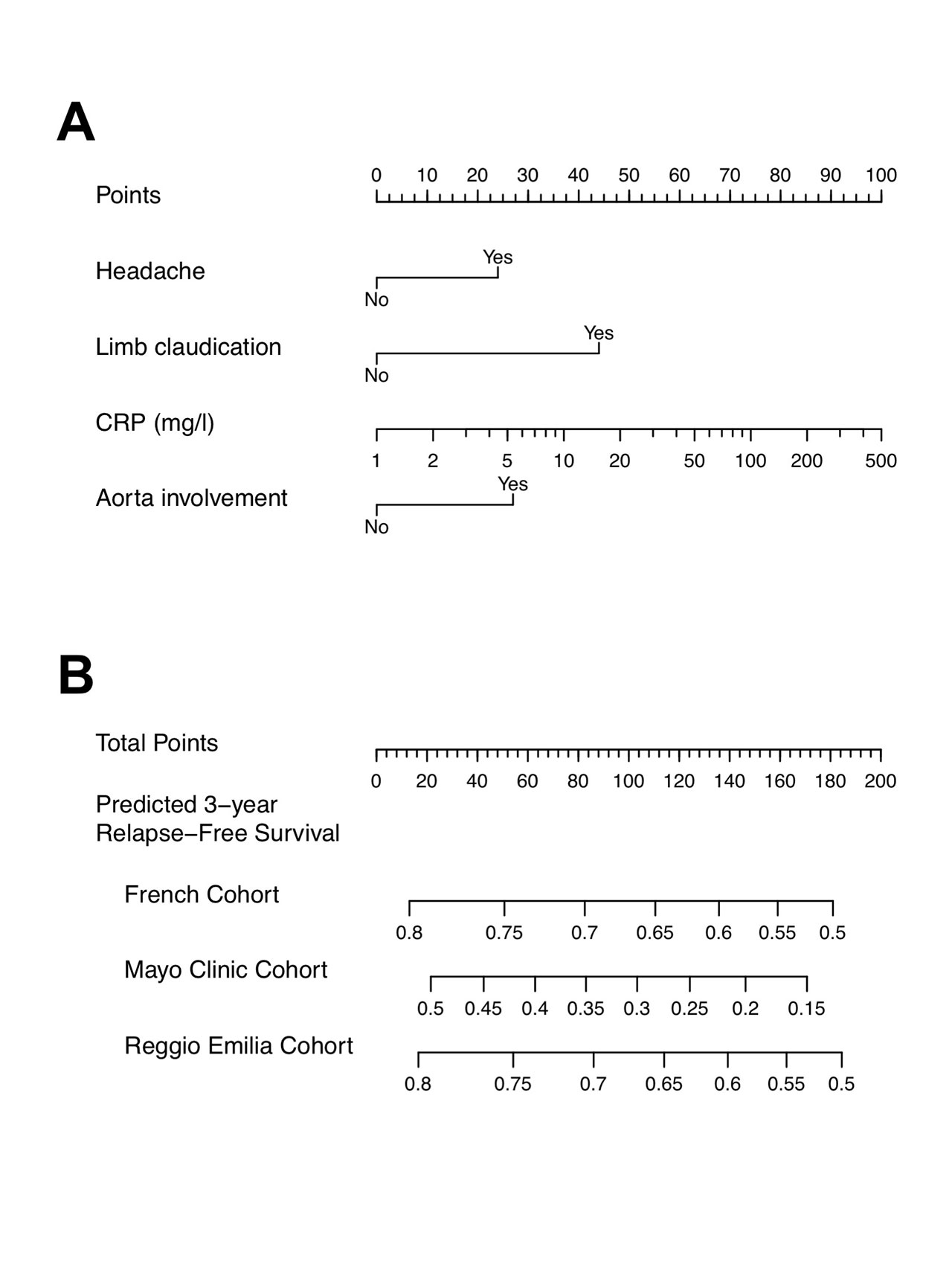Session Information
Date: Tuesday, November 12, 2019
Title: Vasculitis – Non-ANCA-Associated & Related Disorders Poster III: Giant Cell Arteritis
Session Type: Poster Session (Tuesday)
Session Time: 9:00AM-11:00AM
Background/Purpose: Roughly half of giant-cell arteritis (GCA) patients taking only glucocorticoids (GCs) relapse. The relapse rate seems to reflect, in part, the duration of GC intake, more than the initial dose at induction. However, the GCA-relapse rate varied widely in observational studies and randomized–controlled trials. We aimed to identify factors predictive of GCA relapse based on data from patients enrolled in 3 international GCA cohorts.
Methods: This international study included patients ≥50 years old and fulfilling ACR criteria for GCA from three cohorts : Northern Europe (n=351), US (n=285) and Southern Europe (n=142) cohorts. The primary endpoint was the time from diagnosis to first relapse or death. Relapse-free survival was estimated with the Kaplan–Meier product-limit method. Cox proportional hazards models were stratified by cohort. Missing data were handled through multiple imputation by chained equations. Internal validation of the model was carried out using 200 bootstrap resamples, on which the entire model building strategy was repeated. Model performance was evaluated both by the concordance (c) statistic, as a measure of discrimination, and the calibration curve. The final model was presented with hazard ratios (HR) obtained after shrinkage by the calibration slope and their 95% confidence intervals (95% CI).
Results: This study included 778 patients (24% men; median age 71 [IQR 61–78] years). Median follow-up was 51 [IQR 24–102] months. During 36 months of follow-up, 382 patients relapsed; relapse-free survival at 36 months was 45.3% (95% CI 41.6–49.2), with marked differences among the cohorts. French and Reggio Emilia cohorts had better relapse-free survival rates than the Mayo Clinic cohort.
To adjust for optimism induced by the model-selection procedure, regression coefficients where shrunk by multiplying them by the calibration slope, which was 0.714, indicating a reasonable level of overfitting in the original model. The final model (corrected for over-optimism) comprised headaches (HR 1.18, 95% CI 1.00–1.39; P=0.052), limb claudication (HR 1.34, 95% CI 0.95–1.89; P=0.091), aortitis (HR 1.20, 95% CI 0.97–1.48; P=0.096) and CRP levels (after logarithmic transformation) (HR 1.11, 95% CI 1.02–1.22; P=0.014). The model was well calibrated, but with relatively limited discriminative ability. Using the pooled coefficients for each imputed dataset yielded a corrected c-statistic of 0.562 (95% CI 0.525–0.598).
We set up a nomogram allowing the calculation of the predicted 3-year relapse free survival. Points (ranging from 0 to a maximum of 100) is attributed for each of the four previous items (Figure A). Total score (ranging from 0 to 200) is used to predict the 3-year relapse free survival in each cohort (Figure B).
Conclusion: The risk of GCA relapse varies among observational cohorts. A model comprising the headaches, limb claudication, aortitis and CRP levels was well calibrated, and could help identify patients at high-risk of relapse. However, this model had relatively limited discriminative ability, possibly due to unmeasured variables that might explain the observed heterogeneity among cohorts.
To cite this abstract in AMA style:
Delaval L, Porcher R, Warrington K, Muratore F, Crowson C, Blockmans D, Agard C, Régent A, Samson M, Guillevin L, Salvarani C, Terrier B. Predictors of Relapse in Giant Cell Arteritis: Data from an International Collaboration [abstract]. Arthritis Rheumatol. 2019; 71 (suppl 10). https://acrabstracts.org/abstract/predictors-of-relapse-in-giant-cell-arteritis-data-from-an-international-collaboration/. Accessed .« Back to 2019 ACR/ARP Annual Meeting
ACR Meeting Abstracts - https://acrabstracts.org/abstract/predictors-of-relapse-in-giant-cell-arteritis-data-from-an-international-collaboration/

